Isolation and characterization of bacteria from two soil samples and their effect on wheat (Triticum aestivum L.) growth promotion
Abstract
Since ancient times, soil bacteria play an important role on crop growth and yield by genetic transformation naturally. But the continuous use of chemical fertilizers reduces their number and proper environment for multiplication. Seed treatment with beneficial bacteria provides nutrients for the growth of crop plants. Thus, soil bacteria were isolated, their growth characteristics and effect on wheat growth were observed. The maximum growth of Isolate A and Isolate B was observed at pH 5.5, 7.0 and 33°C, 35°C respectively. Morphological characteristics indicated that Isolate A and Isolate B were gram-positive. But both bacteria were non-motile. In Biochemical test, both of them showed positive result in the methyl red test, catalase test, urea test, starch hydrolysis test, and negative in TSI (Triple Sugar Iron) test, mannitol salt test. Isolate B showed positive result in BSA, MacConkey test and EMB (Eosin Methylene Blue) test and Isolate A showed negative result in BSA (Bismuth Sulphite Agar), MacConkey test and EMB test. Besides, both of the bacteria were multi-drug resistance showing resistance to penicillin, amoxicillin, ampicillin cefuroxime, and ceftazidime.16S rRNA gene sequencing identified the isolate A and Isolate B as Bacillus thuringiensis and Bacillus anthracis. After 6 hours of wheat seed treatment germination percentage, fresh root and shoot weight, root and shoot dry weight, relative water content of both root and shoot, and plant growth was enhanced by Bacillus thuringiensis and Bacillus anthracis. Bacillus anthracis was more capable than bacillus thuringiensis for increasing germination rates, both root and shoot growth of wheat. It indicated that Bacillus anthracis and Bacillus thuringiensis mediated growth improvement of wheat is possibly originated in roots.
INTRODUCTION
Soil microorganisms can fix nitrogen, multiply, and release oxygen into the atmosphere and affect soil structure and fertility [1, 2, 3]. These microbes have different characteristics and their advantageous function in soil. Soil bacteria have been used for decades for crop production [4]. Nowadays, in an integrated plant nutrient management system, microbiological approaches have become more popular for crop improvement and yield rather than chemical fertilizers. Use of plant growth promoting rhizobacteria (PGPR) has played a crucial role in crop production, in particular, developing sustainable systems in the plant ecosystem [5, 6]. Symbiotic and non-symbiotic bacteria are now being used worldwide for the enhancement of plant productivity [7, 8]. Besides this, non-symbiotic nitrogen-fixing Bacillus sp. is also being used to inoculate large areas of cultivable land around the world for enhancing plant productivity [9]. Bacillus and Paenibacillus are phosphate-solubilizing bacteria and were applied to soils for enhancing the phosphorus status of plants [10]. Phosphorus is essential for the vigor of all plants and processes from the beginning of seedling growth. Bacillus bacterial species perform many important ecosystem services in the soil including improved soil structure and soil aggregation, recycling of soil nutrients, and water recycling. PGPR have been playing a progressive role in the development of sustainable agricultural systems [11]. Generally, PGPR function in three different ways: particular compounds that are synthesized for the plants [12, 13], facilitating the uptake of some crucial nutrients from the soil [14, 15], and prohibiting the plants from diseases [16-19]. The PGPR mediated plant growth and yield improvement of many crops are not fully understood [20]. Phosphorus (P), an important macronutrient plays a crucial role in plant growth and development [21]. Organic and inorganic phosphates are found in soils as macronutrients. Both organic and inorganic phosphorus induce PGPR for increasing plant yields [22, 23]. Some reports showed microbial phosphorus release from organic P sources [24]. Bacteria strains such as Pseudomonas, Bacillus, Rhizobium, Burkholderia, Achromobacter, Agrobacterium, Micrococcus, Aerobacter, Flavobacterium, and Erwinia can solubilize insoluble inorganic phosphate compounds [25]. But Pseudomonas, Bacillus, and Rhizobium are the most powerful phosphate solubilizers [26, 27]. Bacillus bacterial genera holds potential for developing biofertilizer and biocontrol agents and continued research with these genera will make Bacillus as a potential PGPR and reveal a new era of achieving sustainable crop yield in agriculture. Thus, the present study was designed to isolate and characterize of Bacillus spp. from flooded and unflooded soil and to observe their effect on wheat seeds for plant-growth promoting morphological traits.
MATERIALS AND METHODS
Sample collection
Two soil samples were collected from the different land (Flooded and unflooded) of Bogura district. One of the lands is flooded every year but the other land is never flooded. Samples were aseptically collected in sterile plastic container and transported to the Microbiology Laboratory, Department of Genetic Engineering and Biotechnology, University of Rajshahi, Rajshahi, Bangladesh. Then samples were stored in ice for 16 hours until subsequent analysis in the laboratory. The wheat (BARI gom-33) was collected from regional wheat and maize research center, Shyampur, Rajshahi.
Chemicals
Peptone, yeast extract, bacteriological agar, sodium chloride, ethanol, methanol, sodium hydroxide (NaOH), hydrochloric acid (HCl), crystal violet, and grams iodine were obtained from bioWORLD, USA. Basal salt, mannitol salt, macConkey agar, urea agar, starch agar, TSI agar, simmons citrate agar, EMB agar were purchased from Merck, Germany. All other chemicals and solvents were in analytical grade.
Preparation of mixed bacterial culture
Two (2) gm of each soil sample was mixed with 100 ml distilled water in a beaker and filtered through the whatman filter paper. After filtration 100µl solution was added in Luria-Bertani (LB) liquid medium and incubated for 16-18 hours at 37°C temperature to prepare bacterial mixed culture.
Isolation of pure bacterial culture
After serial dilution, from each tube 100μl of diluted samples were transferred into nutrient agar plates and incubated at 37°C for 24hours. Then single colony was selected and streaked several times for pure bacterial colony. Pure single colony was transferred into LB liquid medium for store and further use.
Morphological and biochemical test
Morphological and biochemical tests were used for specific identification of bacteria. Isolated bacteria were characterized by several morphological and biochemical tests such as gram staining, motility, catalase, methyl red, MacConkey, Mannitol, Urea Hydrolysis, Starch Hydrolysis, Triple Sugar Iron (TSI), Citrate, Bismuth Sulfite Agar (BSA), and Eosin Methylene Blue (EMB) Agar test.
Role of pH and temperature on bacterial growth
To observe the effect of pH on bacterial growth, the culture medium was adjusted to pH ranging from 3.0 to 8.0 with 0.5 intervals. For temperature effect data were recorded at 25°C, 30°C, 33°C, 35°C, 40°C and 45°C. Bacterial cell density was determined by measuring optical density at 600 nm with a UV-Vis spectrophotometer (Analytic Gena, Germany).
Antibiotic sensitivity test of isolated bacteria
Different antibiotics like Penicillin, Amoxicillin, Gentamycin, Tetracycline, Ciprofloxacin, Cefuroxime, Cefixime, Ampicillin, Erythromycin, Erythromycin, Kanamycin, Ceftazidime, and Doxycycline were used for antibiotic sensitivity test. Antibiotic discs were placed carefully on the respective plates and incubated overnight at 370C. After overnight incubation the zone was observed on the plate and measured with the help of mm scale. Gentamycin was used as a control.
Molecular methods for species identification
The 16S rRNA gene was sequenced from Invent technology and compared with other sequences from the gene bank database using Basic Local Alignment Search Tool (BLAST) available from the website www.ncbi.nlm.nih.gov/Blast to identify bacteria [28].
Seed treatment
Fresh bacterial culture was prepared 1 day before seeds treatment. Then seeds were washed thoroughly and immersed in distilled water for 30 min. After immersion they were sterilized with 70% (v/v) ethanol for 3 min and properly washed with distilled water. Then seeds were transferred into fresh bacteria culture and were shook in the shaker for 0.5 h, 1h, 2h, 4h, 6h, 8h and 10h at 37°C. After shaking 30 seeds were placed into each 90 mm petri dish (with three replications) which containing 2 layers moistened of tissue papers at the bottom for germination. The petri dishes were taken on room temperature for germination. The treated and control seeds were watered every day for germination.
Germination percentage analysis
The germination percentage was recorded after 7 days of treatment. The germination percentage was calculated by using the following equation:
Germination percentage = (Number of seeds germinated / total number of seeds inoculated) * 100
Plant growth analysis
Plant growth was measured after 7 days of planting in petri dishes. Root and shoot length were measured in cm and number of roots were counted and compared with the control.
Determination of shoot and root dry weight
To determine shoot and root dry weight, 10 days germinated plants were harvested from the petri dish. Roots and shoots were separated from each other. Roots were washed with distilled water to remove the adherent tissue paper and kept in the dryer incubator at 700 C for 3 days, the dry weight of shoot and root were measured by using electrical balance.
Relative water content (RWC) in root and shoot
The relative water content (RWC) of both roots and shoots for each treatment was calculated according to the formula of Weatherly [29].
RWC = [(FW-DW)/(TW-DW)] × 100.
Where, FW= Fresh weight of shoot/root
DW= Dry weight of shoot/root
TW= Turgid weight of shoot/root
Statistical analysis
All experiments were carried out in triplicates and the results are presented as the mean of three independent observations. Significance of each group data was analyzed statistically at P ≤ 0.05 by ANOVA one-way followed by Duncan’s Multiple Range Test (DMRT) in SPSS Statistics 20 software. Graphs were prepared using GraphPad Prism 8.0 (GraphPad Software, San Diego, CA, USA).
RESULTS
Pure bacterial colony isolation
Isolate A (flooded) and Isolate B (unflooded) were isolated from mixed bacterial culture by using the streak plate method and serial dilution (Figure 1). Colonies were selected according to their morphological characters and nature.
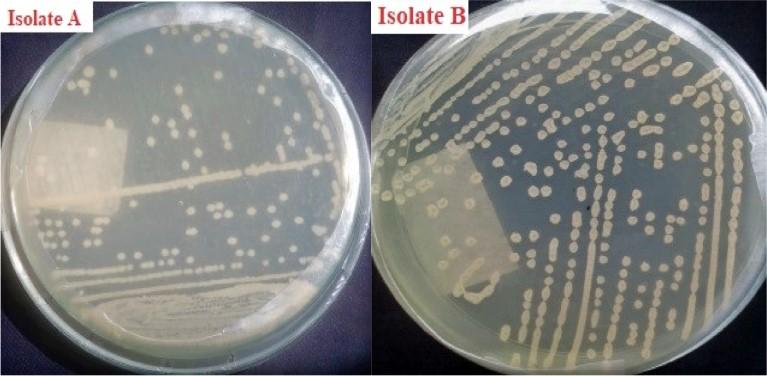
Morphological and biochemical characteristics
The morphological characteristics of isolated bacteria are shown in Figure 1 and Table 1. Both Isolates were almost rod-shaped, gram-positive, and yellowish. Biochemical test results are also shown in Table 1 which indicated that the Isolate-A was positive for Methyl Red test, Catalase test, Urea Hydrolysis test, Starch Hydrolysis test and negative for Motility test, MacConkey test, Mannitol salt test, Simmons’ Citrate test, Bismuth Sulfate Agar (BSA) test, Eosin Methylene Blue (EMB) agar test. Besides this, Isolate B was positive for Methyl Red test, Catalase test, MacConkey test, Urea Hydrolysis test, Starch Hydrolysis test, Simmons’ Citrate test and negative for Motility test and Mannitol salt test.
Table 1. The results of morphological and biochemical test of Isolate A and Isolate B.
Antibiotic sensitivity test
The results (Figure 2) showed that, Isolate A had no intermediate resistance but was susceptible to gentamycin, tetracycline, ciprofloxacin, erythromycin, kanamycin, and doxycycline and resistant to penicillin, ampicillin, amoxicillin, cefuroxime, cefixime and ceftazidime (Table 2). On the other hand, Isolate B was intermediate resistant to tetracycline and susceptible to gentamycin, ciprofloxacin, cefixime, erythromycin, kanamycin, doxycycline and resistant to penicillin, amoxicillin, ampicillin, cefuroxime, and ceftazidime. So, Isolate A and isolate B did not show similar characteristics in antibiotic sensitivity tests.
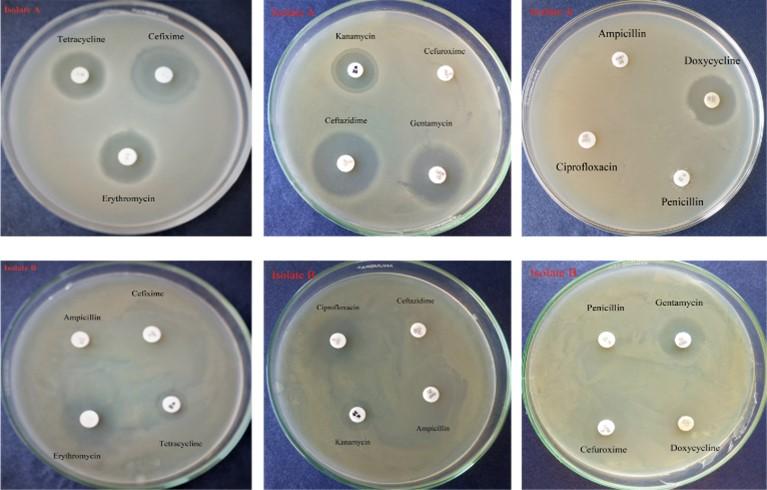
Table 2. Antibiotic sensitivity test for detection of the resistance pattern of isolated bacteria.
Role of pH and temperature on bacterial growth
The optimal growth conditions of Isolate A and Isolate B were determined with different pH ranging from 3.0 to 8.0. Isolate A and Isolate B showed maximum growth at pH 5.5 and 6.5 respectively (Figure 3A). The temperature effect on bacterial growth was also measured in various temperatures ranging from 25 to 45°C with an interval of 5.0. Isolate A and Isolate B showed their maximum growth at 33°C and 35°C respectively (Figure 3B).
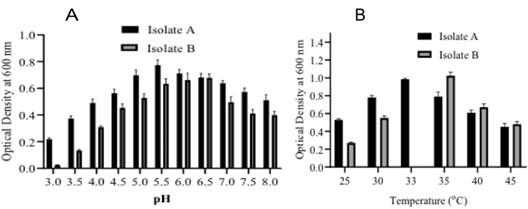
Species identification
From the 16S rRNA gene sequence comparison, Isolate A showed 99.51% similarity with Bacillus thuringiensis and Isolate B showed 99.04% similarity with Bacillus anthracis. Thus, Isolate A and Isolate B were confirmed as Bacillus thuringiensis and Bacillus anthracis, respectively.
Germination percentage
Among different treatment duration, seed germination percentage was increased due to treatment for 6 hours (Figure 4) with both the bacterial strains in comparison to control (Figure 4). After 7 days, Bacillus thuringiensis treated seed germination rate was 77.78% whereas Bacillus anthracis treated seed germination rate was 85.56%. Between these two bacteria, Bacillus anthracis showed better results in seed germination (Figure 4)
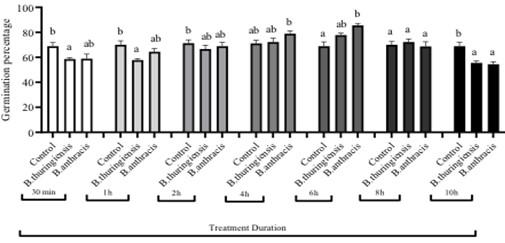
Morphological and physiological characteristics of wheat seedlings
Bacillus thuringiensis and Bacillus anthracis treatment caused a remarkable increase in root length, shoot length, both root and shoot dry weight in wheat seedlings compared to controls. Significant changes were observed in shoot length, root length, fresh shoot weight and fresh root weight in wheat seedlings compared to controls due to seed treatment with the B. anthracis but in case of B. thuringiensis non-significant changes were observed in the above mentioned characters (Figure 5)
However, shoot dry weight significantly increased in seedlings treated with B. anthracis. Whilst other characteristics such as root dry weight, relative water content in shoot and root showed no significant changes due to treatment with both the bacteria, but relative water content in root was remarkably decreased due to the treatment with B. thuringiensis (Figure 5). In all the parameters, Bacillus anthracis showed more significant results than control and Bacillus thuringiensis.
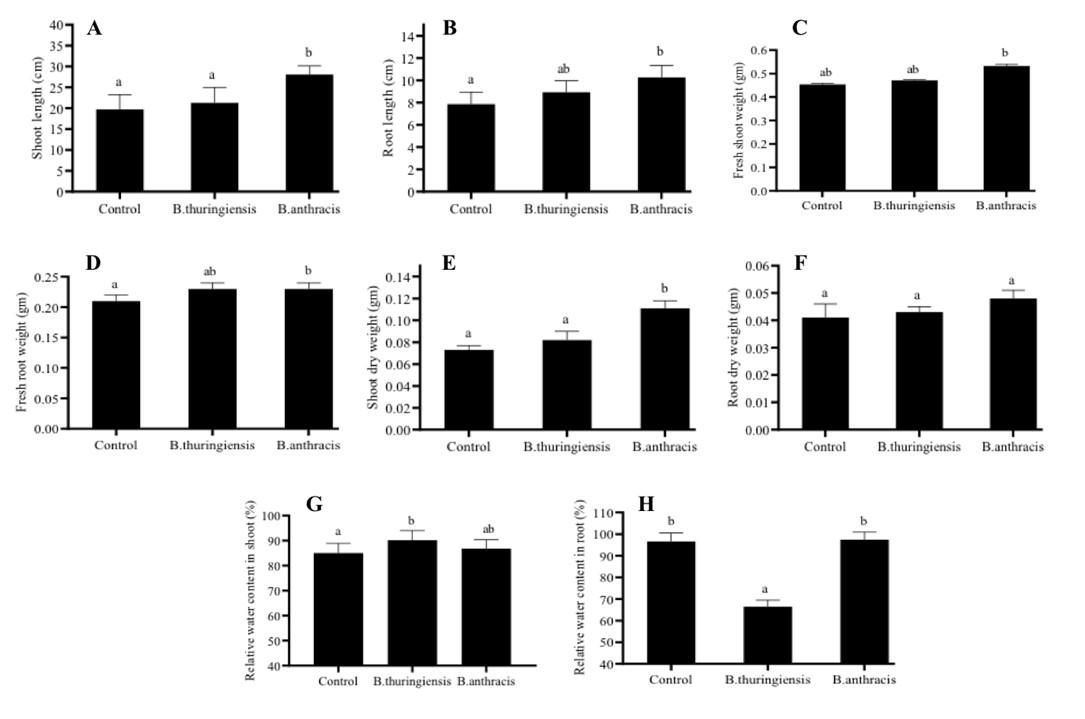
DISCUSSION
Improvement of crop plants is highly desirable to fulfill the demand of the vast population. Beneficial bacterial treatment of seeds has been proven to be efficient in crops species whilst induced mechanism of PGPR for germination and growth remains to be uncertain.
This study reveals new insights into the role of seed treatment technology for triggering the germination and growth of wheat plants. Application of beneficial bacteria for seed treatment to increase yield and reduce use of pesticide and chemical fertilizer, which is harmful to both humans and environments. So, it is very attractive, and benefits could be considerable. The commercial use of beneficial bacteria as a common agricultural practice will depend on such aspects as cost-benefit ratios, wide-spread applicability of specific strains. Bacillus thuringiensis and Bacillus anthracis preferred ecological niche is also home to various other types of soil micro-organisms due to its rich nutrient availability.
In this study we also optimized and characterized the primarily isolated strains [30]. They showed maximal growth at different pH and temperature. However, isolate-A revealed maximum growth at pH 5.5 in 33ºC and isolate B at pH 6.5 in 35ºC after 24 hours incubation. Many bacteria are resistant to some of common antibiotics and these antibiotics can’t kill the bacteria. So, antibiotics sensitivity analysis is a useful tool to help quickly determine if bacteria are resistant to certain drugs. Examples of antibiotic-resistant infections include: a persistent sore throat, a recurring urinary tract infection (UTI) and an unresponsive case of pneumonia [31]. Isolate A was susceptible to gentamycin, tetracycline, ciprofloxacin, erythromycin, kanamycin, and doxycycline and resistant to penicillin, ampicillin, amoxicillin, cefuroxime, cefixime and ceftazidime. On the other hand, Isolate B was intermediate resistant to tetracycline and susceptible to gentamycin, ciprofloxacin, cefixime, erythromycin, kanamycin, doxycycline and resistant to penicillin, amoxicillin, ampicillin, cefuroxime, and ceftazidime
After isolation, two Bacillus spp. were used for seed treatment and their effect on seed germination, root-shoot growth, fresh root-shoot weight, root-shoot dry weight, relative water content of root-shoot of wheat were measured. After 7 days, control wheat variety showed 68.89% germination with an average of 19.73 cm shoot and 7.87 cm root length whereas seeds treated with Bacillus thuringiensis showed maximum 77.78% germination with 3.4 cm shoot and 8.93 cm root length but 85.56% germination with 28.07 cm shoot and 10.27 cm length was achieved by Bacillus anthracis seed treatment. Plant growth promoting rhizobacteria (PGPR) can improve the extent of plant growth directly or indirectly. A study reported that Pseudomonas, Azospirillum, Azotobacter, Klebsiella, Bacillus, and Serratia could increase plant growth [32]. Both bacteria have the ability to increase the growth of wheat plant but overall Bacillus anthracis showed the best results compared to Bacillus thuringiensis on root-shoot growth. Bacillus megaterium strain (RmBm31) that possesses a wide range of genomic features linked to plant growth promotion. [33]. It acts as a PGPR with biological promotion of different characteristics of plant growth [34]. Many Bacillus species are well-known plant-growth promoters, capable of promoting plant nutrient uptake, controlling phytopathogens, and producing phytohormones [35]. All these enhanced the plant growth as a result of their ability to fix nitrogen. Other mechanism may be attributed to growth promotion by plant growth promoting hormones production and other PGR activities [36].
The RWC showed 86.83% in shoot and 97.38% in root treated with Bacillus anthracis, whereas seeds treated with Bacillus thuringiensis showed a maximum of 90.26% in shoot and 66.43% in root RWC but control showed 85.04% in shoot and 96.63% in root RWC. In this case, seed treated with Bacillus anthracis increased both root and shoot relative water content. Water status in leaf is related to several leaf physiological variables, such as leaf turgor, growth, stomatal conductance, photosynthesis and respiration [37]. Water content is used to quantify the water presence in shoot and root tissues. So, shoot and root water content is a useful indicator of plant water balance. Potential water provides energetic status of shoot and root [38].
Though Bacillus anthracis is considered as an obligate agent that cause anthrax in humans, livestock and wildlife, it also may promote plant growth when inoculated into carcass site soil [39]. Bacillus anthracis can interact with plants (Enneapogon desvauxii) and promote anthrax transmission [39]. So, for considering this bacterium as wheat growth promoting purpose, more studies should be carried out about its transmission through this crop and subsequent effects on yield and other quantitative traits of wheat (Figure 6).
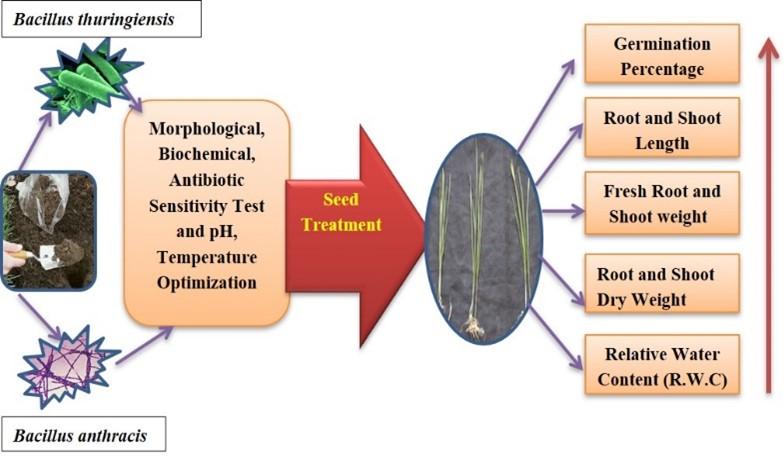
CONCLUSION
Our findings collectively point out that inoculation of wheat seed with both Bacillus thuringiensis and Bacillus anthracis for 6 hours could be the way for rapid enhancement of plant morphological characteristics. Thus, both the bacteria can be used for wheat growth promotion at the field level.
ACKNOWLEDGEMENT
We acknowledge Regional Wheat Research Center (Bangladesh Agricultural Research Institute, Shyampur Rajshahi-6212) for supplying wheat seed. The authors received no funding from an external source.
AUTHOR CONTRIBUTIONS
GKP and MAS conceived the idea. GKP performed all experiments. GKP and SM prepared manuscript. MAS supervised the research and revised the manuscript. SZ, MSU and MAS arranged the whole facilities for the research. KN, TJ, MLM and MNH helped for performing the experiments. All of the authors read and approved the manuscript.
CONFLICTS OF INTEREST
The author (s) declared no potential conflicts of interest with respect to the research, authorship and publication of this article.
References
- [1]Farquhar J, Bao H, Thiemens M. Atmospheric influence of Earth’s earliest sulfur cycle. sci. 2000; 289(5480): 756-758.
- [2]Canfield DE. Oxygen: a four billion years history. Princeton University Press. 2014.
- [3]Falkowski PG. Life’s engines: how microbes made Earth habitable. Princeton University Press 2015; Vol. 24.
- [4]Hayat R, Ali S, Amara U, Khalid R, Ahmed I. Soil beneficial bacteria and their role in plant growth promotion: a review. Ann Microbiol. 2010; 60(4): 579-598.
- [5]Sturz AV, Nowak J. Endophytic communities of rhizobacteria and the strategies required to create yield enhancing associations with crops. APPL SOIL ECOL 2000; 15(2): 183-190.
- [6]Shoebitz M, Ribaudo CM, Pardo MA, Cantore ML, Ciampi L, et al. Plant growth promoting properties of a strain of Enterobacter ludwigii isolated from Lolium perenne rhizosphere. Soil Biol Biochem 2009; 41(9): 1768-1774.
- [7]Burd GI, Dixon DG, Glick BR. Plant growth-promoting bacteria that decrease heavy metal toxicity in plants. Can J Microbiol. 2000; 46(3): 237-245.
- [8]Cocking EC. Endophytic colonization of plant roots by nitrogen-fixing bacteria. Plant Soil 2003; 252(1): 169-175.
- [9]Ma Y, Oliveira RS, Wu L, Luo Y, Rajkumar M, Rocha I, Freitas H. Inoculation with metal-mobilizing plant-growth-promoting rhizobacterium Bacillus sp. SC2b and its role in rhizoremediation. J Toxicol Environ. 2015; 78(13-14): 931-944.
- [10]Awasthi R, Tewari R, Nayyar H. Synergy between plants and P-solubilizing microbes in soils: effects on growth and physiology of crops. Int Res J Microbiol 2011; 2(12): 484-503.
- [11]Gouda S, Kerry RG, Das G, Paramithiotis S, Shin HS, et al. Revitalization of plant growth promoting rhizobacteria for sustainable development in agriculture. Microbiol Res 2018; 206: 131-140.
- [12]Dobbelaere S, Vanderleyden J, Okon Y. Plant growth-promoting effects of diazotrophs in the rhizosphere. CRIT REV PLANT SCI 2003; 22(2):107-149.
- [13]Zahir ZA, Arshad M, Frankenberger WT. Plant growth promoting rhizobacteria: applications and perspectives in agriculture. Adv Agron. 2004; 81(1): 98-169.
- [14]Li L, Tilman D, Lambers H, Zhang FS. Plant diversity and overyielding: insights from belowground facilitation of intercropping in agriculture. New Phytol.2014; 203(1): 63-69.
- [15]Cakmakçi R, Dönmez F, Aydın A, Şahin F. Growth promotion of plants by plant growth-promoting rhizobacteria under greenhouse and two different field soil conditions. Soil Biol Biochem. 2006; 38(6): 1482-1487.
- [16]Guo JH, Qi HY, Guo YH, Ge HL, Gong LY, et al. Biocontrol of tomato wilt by plant growth-promoting rhizobacteria. Biol Control 2004; 29(1): 66-72.
- [17]Jetiyanon K, Kloepper JW. Mixtures of plant growth-promoting rhizobacteria for induction of systemic resistance against multiple plant diseases. Biol Control 2002; 24(3): 285-291.
- [18]Raj SN, Deepak SA, Basavaraju P, Shetty HS, Reddy MS, et al. Comparative performance of formulations of plant growth promoting rhizobacteria in growth promotion and suppression of downy mildew in pearl millet. J Crop Prot 2003; 22(4): 579-588.
- [19]Saravanakumar D, Lavanya N, Muthumeena B, Raguchander T, Suresh S, et al. Pseudomonas fluorescens enhances resistance and natural enemy population in rice plants against leaf folder pest. J Appl Entomol 2008; 132(6): 469-479.
- [20]Bhattacharyya PN, Jha DK. Plant growth-promoting rhizobacteria (PGPR): emergence in agriculture. WORLD J MICROB BIOT 2012; 28(4): 1327-1350.
- [21]Mmbaga GW, Mtei KM, Ndakidemi PA. Extrapolations on the use of rhizobium inoculants supplemented with phosphorus (P) and potassium (K) on growth and nutrition of legumes. Int J Agric Sci. 2014; 5(12): 1207.
- [22]Babalola OO. Beneficial bacteria of agricultural importance. Biotechnol Lett. 2010; 32(11): 1559-70.
- [23]Rodríguez H, Fraga R, Gonzalez T, Bashan Y. Genetics of phosphate solubilization and its potential applications for improving plant growth-promoting bacteria. Plant Soil 2006; 287(1-2): 15-21.
- [24]Jalali M, Ranjbar F. Rates of decomposition and phosphorus release from organic residues related to residue composition. J PLANT NUTR SOIL SC 2009; 172(3): 353-359.
- [25]Ngoma L, Esau B, Babalola OO. Isolation and characterization of beneficial indigenous endophytic bacteria for plant growth promoting activity in Molelwane Farm, Mafikeng, South Africa. Afr J Biotechnol. 2013; 12(26): 4105-4114.
- [26]Banerjee S, Palit R, Sengupta C, Standing D. Stress induced phosphate solubilization by ‘Arthrobacter’ Sp. And ‘Bacillus’ sp. isolated from tomato rhizosphere. Aust J Crop Sci. 2010; 4(6): 378.
- [27]Wakelin SA, Warren RA, Harvey PR, Ryder MH. Phosphate solubilization by Penicillium spp. closely associated with wheat roots. Biol Fertil. 2004; 40(1): 36-43.
- [28]Stach JE, Bathe S, Clapp JP, Burns RG. PCR-SSCP comparison of 16S rDNA sequence diversity in soil DNA obtained using different isolation and purification methods. FEMS Microbiol Ecol. 2001; 36(2-3): 139-151.
- [29]Weatherly PE. Studies in the water relations of cotton. I. The field measurement of water deficit in leaves. New Phytol. 1950; 49: 81-97
- [30]Sharmin S, Hossain MT, Anwar MN. Isolation and characterization of a protease producing bacteria Bacillus amovivorus and optimization of some factors of culture conditions for protease production. J Biol Sci. 2005; 5(3): 358-362.
- [31]Hudzicki J. 2009. Kirby-Bauer disk diffusion susceptibility test protocol.
- [32]Etminani F, Harighi B. Isolation and identification of endophytic bacteria with plant growth promoting activity and bio control potential from wild pistachio trees. Plant Pathol J. 2018; 34(3): 208.
- [33]Dahmani MA, Desrut A, Moumen B, Verdon J, Mermouri L, et al. Unearthing the Plant Growth Promoting Traits of Bacillus megaterium RmBm31, an Endophytic Bacterium Isolated From Root Nodules of Retama monosperma. Front. Plant Sci. 2020; 11:124.
- [34]Sansinenea E. Bacillus spp.: As Plant Growth Promoting Bacteria. Springer Nature Singapore Pte Ltd. 2019; pp. 225-237
- [35]Tiwari S, Prasad V, Lata C. Bacillus: Plant Growth Promoting Bacteria for Sustainable Agriculture and Environment. Elsevier 2019; Pp.43-55
- [36]Kumar A, Kumar A, Devi S, Patil S, Payal C, et al. Isolation, screening and characterization of bacteria from rhizospheric soils for different plant growth promotion (PGP) activities: an in vitro study. Recent res sci. 2012; 4(1): 01-05.
- [37]Galmés J, Flexas J, Savé R, Medrano H. Water relations and stomatal characteristics of Mediterranean plants with different growth forms and leaf habits: responses to water stress and recovery. Plant Soil 2007; 290(1-2): 139-155.
- [38]Jones HG. Monitoring plant and soil water status: established and novel methods revisited and their relevance to studies of drought tolerance. J Exp Bot. 2007; 58(2): 119-130.
- [39]Ganz HH, Turner WC, Brodie EL, Kusters M, Shi Y, et al. Interactions between Bacillus anthracis and Plants May Promote Anthrax Transmission. PLoS Negl Trop Dis. 2014; 8(6): e2903.